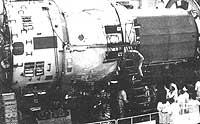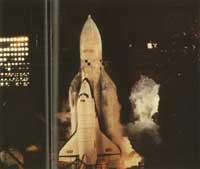New spaces
1988/12/01 Oilarra, A. Iturria: Elhuyar aldizkaria
We started with good news. The Americans put the ferry Discovery into orbit last September. This was the first ferry launch after the Challenger crash. It took two and a half years to review the ferry design and develop the necessary safety measures. Among the novelties is the system that will save astronauts in case of an accident during launch. If the Challenger case happened again, nothing would happen to the crew with the new system. The launch and subsequent orbit sessions were a success. Thanks to this, the American space program is expected to receive a new and strong momentum.

The Soviets are also about to launch their ferry program. When this information has been written, the Buran ferry has not yet been launched. The Soviets had to suspend the first session in the last seconds of the countdown. One of the towers used to keep the Buran ferry and the Energia projectile standing was not completely discarded and endangered the launch. The Soviets decided to make the shot still, although the risk was minimal.
The next session had to be delayed, as to check the systems they had to empty the fuel tanks. Buran on his first flight did not have to carry crew members and wanted to prove the maneuverability of the ship. The next edition will take place in mid-November. For the launch of this issue of Science and Technology it is possible that the Soviet ship has already made a space tour.
Meanwhile, in mid-November, cosmonauts Vladimir Titov and Musa Maranov beat the record set by Juri Romanenko last year. Romanenko spent 325 days at the space station Mir and Titov and Maranov want to add 40 more days to this brand. His return is expected to take place on the next day of St. Thomas. Meanwhile, they will visit the French cosmonaut Jean-Loup Chretien. This is the second time the French cosmonaut travels into space. The third crew of the Mir station, doctor Valeri Poliakov, will remain until April.
We will quote a bad news to end these brief news about space. In this magazine we talked a lot about the automatic Phobos probes that the Soviets have sent to Mars. As a result of the combustion of a controller last September, the Soviets have lost contact with the Phobos 1 probe and do not seem to be able to recover. The antenna collecting signals emitted from the ground has lost the target and is not Earth-oriented. Therefore, the probe is currently without control. Fortunately, the second probe runs smoothly.

Gai honi buruzko eduki gehiago
Elhuyarrek garatutako teknologia




